 W
WThe Intangible Cultural Heritage are aspects of intangible culture that the government of South Korea has officially designated for preservation in accordance with the 1962 Cultural Property Protection Law. They are proclaimed and maintained by South Korea's Cultural Heritage Administration.
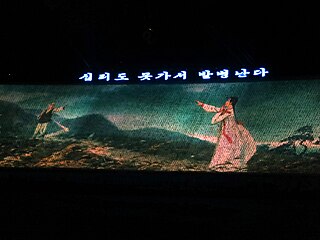 W
W"Arirang" is a Korean folk song. There are about 3,600 variations of 60 different versions of the song, all of which include a refrain similar to, "Arirang, arirang, arariyo " It is estimated the song is more than 600 years old.
 W
WBeopju is a type of cheongju. The name literally means "law liquor", as it is made following a fixed procedure. On 1 November 1986, a variety called Gyodong-beopju was designated by the government of South Korea as Intangible Cultural Property.
 W
WCheoyongmu is a representative Korean mask dance based on the legend of Cheoyeong, a son of the Dragon King of the Eastern Sea. It is also the oldest surviving Korean court dance created during the Unified Silla period. Cheoyongmu has also been considered as a shamanistic dance because it was performed to drive off evil spirits at the end of the year.
 W
WThe daegeum is a large bamboo flute, a transverse flute used in traditional Korean music. It has a buzzing membrane that gives it a special timbre. It is used in court, aristocratic, and folk music, as well as in contemporary classical music, popular music, and film scores. And daegeum has a wide range and has a fixed pitch, so other instruments tune in to the daegeum when playing together.
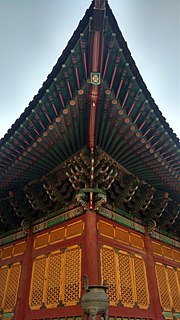 W
WDaemokjang is a style of traditional Korean wooden architecture and a term for the woodworking artisans who create it. The word is derived from mokjang or moksu, meaning carpenter. Mokjang are artisans who deal with wood and are divided into Somokjang and Daemokjang. Somokjang make small wooden objects; Daemokjang build large wooden buildings. Daemokjang cover the entire field of woodworking and the entire construction process.
 W
WThe Eunyul talchum is a type of talchum, Korean traditional mask drama which has been handed down in Eunyul, Hwanghae Province, present North Korea. It is also one of sandaenori, a mask dance that developed in Seoul and the mid-metropolitan region. It is designated as the No. 61 asset of the Important Intangible Cultural Properties by South Korea.
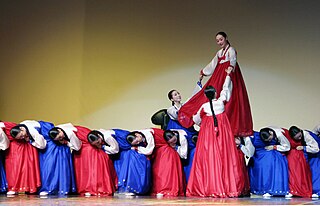 W
WGanggangsullae is an ancient Korean dance that was first used to bring about a bountiful harvest and has developed into a cultural symbol for Korea. It incorporates singing, dancing, and playing and is exclusively performed by women. The dance is mostly performed in the southwestern coastal province of Jeollanam-do. It is often associated with the Chuseok holiday and Daeboreum. They dance all night and continue to play folk games in circles. The performance starts with a late Ganggangsullae and changes to a 'Jajeun-Ganggangsullae', which are characterized by the most beautiful and feminine charms of late Ganggangsullae, and 'Jung-Ganggangsullae" only in the Haenam and Jindo provinces.
 W
WGangneung Danoje is a local festival in Korea which is selected as the 13th Important Intangible Cultural Properties of Korea next to Jinju geommu. It culminates on the fifth day of the fifth month of the year according to the lunar calendar, in Gangneung, Gangwon Province. However, the festival, including preparations such as making special alcohol actually takes 45 days in total. Danoje referred to Suritnal which means the highest day and the God's day. Gangneung Danoje has the longest history among Korean local festivals and its main purpose is to worship the guardian spirit of a mountain which protects the town and pray for the peace of the town and all families and prosperity of farming. It is designated as part of South Korea's Masterpieces of the Oral and Intangible Heritage of Humanity by UNESCO on November 25, 2005.
 W
WGeommu is a traditional sword dance practiced in Korea. Geommu is performed with special costume, dance moves, and music. The dance is known for its grace in performance. Extra emphasis is placed on the movement of the costuming, notably the sleeves, in harmony with the movements of the dancer. The symbolic use of ssang dan geom, i.e. a replica of dual short swords, keeps to the militaristic origins of this dance. Geom-mu has become a dance of great beauty and is treasured as the South Korea's 12th Important Intangible Cultural Property.
 W
WThe geomungo or hyeongeum is a traditional Korean plucked zither with both bridges and frets. Geomungo is a representative stringed instrument made in Goguryeo before the 5th century. Scholars believe that the name refers to Goguryeo and translates to "Goguryeo zither" or that it refers to the colour and translates to "black crane zither".
 W
WGeumbak is a Korean traditional craft for applying extremely thin gold leaf on hanbok, or other fabrics for decoration. Artisans who specialize in the technique are called geumbakjang (금박장).
 W
WGimjang (김장), also spelled kimjang, is the traditional process of preparation and preservation of kimchi, the spicy Korean fermented vegetable dish, in the wintertime. During the summer months, Kimchi is made fresh, from seasonal vegetables. For one month, starting from the tenth moon of the year, people prepare large quantities of kimchi, to provide nutrition throughout winter.
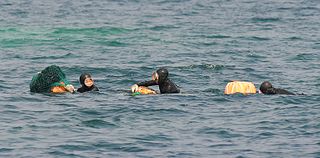 W
WHaenyeo are female divers in the Korean province of Jeju. whose livelihood consists of harvesting a variety of mollusks, seaweed, and other sea life from the ocean. Known for their independent spirit, iron will and determination, haenyeo are representative of the semi-matriarchal family structure of Jeju.
 W
WHahoe byeolsingut talnori or "Hahoe special ritual drama to the gods" is a Korean masked dance-drama performed every three, five, or ten years at the request of the village deity in Hahoe, Andong, North Gyeongsang Province. The village is a UNESCO World Heritage Site, the dance-drama an Important Intangible Cultural Property, and a collection of thirteen (13) masks are a National Treasure. The ritual shares some of the major themes of Korean masked drama and Korean shamanism, namely satire and the ridicule of apostate Buddhist priests and the nobility.
 W
WHwahyejang (Korean: 화혜장) are craftsmen who construct traditional Korean footwear. The shoes are classified into hwa and hye, hence the compound word "hwahyejang". Historically, the two distinct types of shoe were made by separate specialist craftsmen, the hyejang and the hwajang.
 W
WImsil Pilbong nongak(한국어 : 임실필봉농악) is a type of Korean folk music (pungmul-nori) from Pilbong-ri, Gangjin-myeon, Imsil-gun, North Jeolla province. It was designated as No.11-5 asset of the Important Intangible Cultural Property by the South Korean government. It was added to the UNESCO intangible cultural heritage list on November 27, 2014. It passed on the tradition of Honam-jwado nongak and was made famous by Yang Sun-yong
 W
WJeju Chilmeoridang Yeongdeunggut is a shaman ritual that is held on Jeju Island, South Korea at the start of the Korean New Year. The people of Jeju, especially those in the Gwideok, Geumnyeong, and Aewol areas put up 12 posts in the shape of horse heads and colorful silk fabrics to cheer up the goddess Yeongdeung Halmang, who is believed to have visited their place in Korean shamanism. The gut is led by a male dukun until the 15th. At night, lanterns (yeondeung) are installed on the two posts, so this ritual is also called yeondeungje or lantern festival. During the day, the horse carved into the stake looks like a galloping horse, so the gut is also known as yakma bui or galloping horse game.
 W
WJongmyo is a Confucian shrine dedicated to the perpetuation of memorial services for the deceased kings and queens of the Korean Joseon Dynasty (1392–1897). According to UNESCO, the shrine is the oldest royal Confucian shrine preserved and the ritual ceremonies continue a tradition established in the 14th century. Such shrines existed during the Three Kingdoms of Korea period (57-668), but these have not survived. The Jongmyo Shrine was added to the UNESCO World Heritage list in 1995.
 W
WJongmyo Jerye or Jongmyo Daeje is a rite held for worshipping the late kings and queens of the Joseon Dynasty in Jongmyo Shrine, Seoul, South Korea. It is held every year on the first Sunday of May. The Jongmyo rite is usually accompanied with the court music playing (Jerye-ak) and dance called Ilmu or line Dance. Jongmyo Jerye and Jeryeak were designated as the first of South Korea's Masterpieces of the Oral and Intangible Heritage of Humanity by UNESCO in 2001.
 W
WJuldarigi is a traditional Korean sport similar to tug of war. It has a ritual and divinatory significance to many agricultural communities in the country, and is performed at festivals and community gatherings. The sport uses two huge rice-straw ropes, connected by a central peg, which are pulled by teams representing the East and West sides of the village. A number of religious and traditional rituals are performed before and after the actual competition.
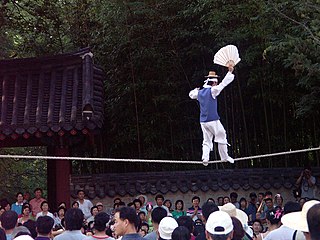 W
WJultagi or eoreum is traditional Korean performance of tightrope-walking. It is included into South Korea's Important Intangible Cultural Properties number 58.
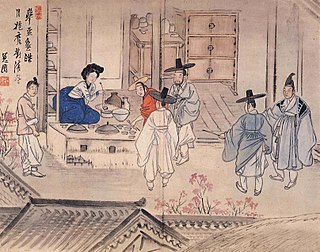 W
WKorean cuisine has a wide variety of traditional alcoholic drinks, known as sul (술). Many of these drinks end with the Sino-Korean word -ju, and some end with the native Korean word -sul. The Sino-Korean -ju is not used as an independent noun.
 W
WKorean royal court cuisine was the style of cookery within Korean cuisine traditionally consumed at the court of the Joseon Dynasty, which ruled Korea from 1392 to 1910. There has been a revival of this cookery style in the 21st century. It is said that twelve dishes should be served along with rice and soup, with most dishes served in bangjja (bronzeware).
 W
WMunbaeju is a Korean traditional distilled liquor produced in South Korea and is considered to be one of the finest Korean spirits. Its name consists of the two words; munbae (문배), which means "wild pear", and ju, meaning "alcohol". It is given this name because the wine has the fruity scent of the wild pear, although no pear is used in its production.
 W
WThe namsadang is a Korean itinerant troupe which consists of male performers who present various performing arts such as acrobatics, singing, dancing and playing like a circus. It is said that namsadang was spontaneously formed before 1900 during the Joseon Dynasty and used to wander about marketplaces and villages. The troupe was considered the lowest class in society along with cheonmin or baekjeong (butchers), so that very few historical documents remain on them. However, since a record that a puppet show was performed during the Silla period has been found, it is assumed that similar types of itinerant companies appeared in Korean history a long time ago.
 W
WPansori is a Korean genre of musical storytelling performed by a singer and a drummer.
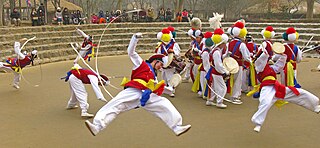 W
WPungmul is a Korean folk music tradition that includes drumming, dancing, and singing. Most performances are outside, with dozens of players all in constant motion. Pungmul is rooted in the dure farming culture. It was originally played as part of farm work, on rural holidays, at other village community-building events, and to accompany shamanistic rituals, mask dance dramas, and other types of performance. During the late 1960s and 1970s it expanded in meaning and was actively used in political protest during the pro-democracy movement, although today it is most often seen as a performing art.
 W
WSeungmu is a Korean dance performed by Buddhist monks. It is one of the most famous Korean traditional dances and designated as South Korea's important intangible cultural asset number 27 in 1969. It has been developed into a solo dance by professional dancers.
 W
WSongpa Sandae Noli is a type of sandae noli, Korean traditional mask play which has been handed down in the neighborhoods of Songpa-dong and Garak-dong in modern-day Seoul, South Korea. Sandae Noli is a mask dance that developed in Seoul and the mid of metropolitan region.
 W
WSsireum or Korean wrestling is a folk wrestling style and traditional national sport of Korea that began in the fourth century.
 W
WTaekkyon, Taekgyeon, Taekkyeon, or Taekyun is a traditional Korean martial art.
 W
WTaepyeongmu is a Korean dance with the function of wishing a great peace for the country. Its exact origin is unknown, but certain style of the present was composed by Hahn Seongjun, an outstanding master of Korean dance in the beginning of last century. There are three assumptions regarding the origin of Taepyeongmu. One is a court dance occasionally performed by kings during the Joseon dynasty. Therefore, the costumes used by the dancers are similar to the gwanbok formerly worn by Korea's kings and queens.
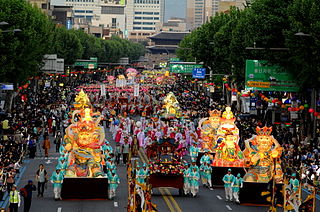 W
WYeondeunghoe is a lantern-lighting festival in Korea celebrating, the Buddha's Birthday. It is inscribed in UNESCO Intangible Cultural Heritage List from 2020 and enlisted as South Korean Intangible Cultural Property from 2012.